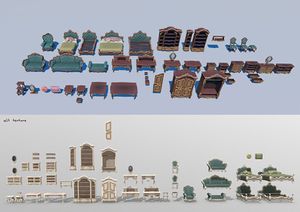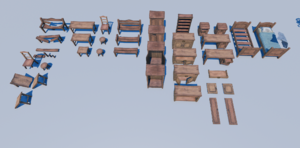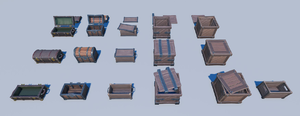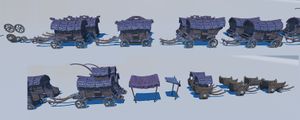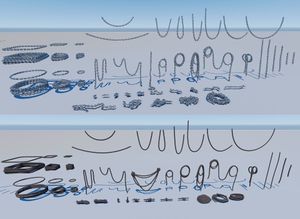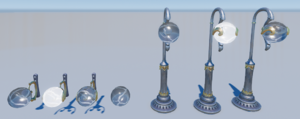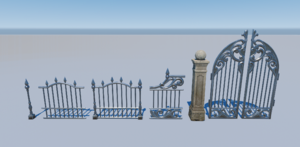3D Asset Workflow: Asset Assembling: Difference between revisions
Jump to navigation
Jump to search
Created page with "= Summary = Check also 3D Asset Workflow: Blocksets and 3D Asset Workflow: Tile Textures and Trimsheets * After the 3D asset set pieces are retopoed, UV mapped, and t..." |
mNo edit summary |
||
| (4 intermediate revisions by the same user not shown) | |||
| Line 1: | Line 1: | ||
<div style="border-bottom:2px solid #99aac7; background:#d0def5; padding:0.4em 0.5em; font-size:130%; margin-bottom: 25px; text-align: center; float:top;"> | |||
⬑ [[3D Asset Workflow]]</div> | |||
<div style="border-bottom:2px solid #99aac7; background:#d0def5; padding:0.4em 0.5em; font-size:130%; float:right; margin-bottom: 25px;"> | |||
Next step: [[3D Asset Workflow: Naming the Asset]] →</div> | |||
<div style="border-bottom:2px solid #99aac7; background:#d0def5; padding:0.4em 0.5em; font-size:130%; float:left; margin-bottom: 25px;"> | |||
← Previous step: [[3D Asset Workflow: UV Mapping]]</div> | |||
<div style="padding-right: 10px; padding-left: 1000px; padding-top: 60px; padding-bottom: 80px;"> | |||
{{#lst:3D Asset Workflow}} <!-- Link list transcluded from main 3D Asset Workflow page --> | |||
</div> | |||
= Summary = | = Summary = | ||
Check also [[3D Asset Workflow: Blocksets]] and [[3D Asset Workflow: Tile Textures and Trimsheets]] | Check also [[3D Asset Workflow: Blocksets]] and [[3D Asset Workflow: Tile Textures and Trimsheets]] | ||
| Line 28: | Line 39: | ||
= Asset Assembly Example Gallery = | = Asset Assembly Example Gallery = | ||
<div class="toccolours mw-collapsible mw-collapsed" style="background-color: # | <div class="toccolours mw-collapsible mw-collapsed" style="background-color: #f3e9f5; border-width:2px; border-radius:10px; margin: 5px;"> | ||
Asset Assembly Example Gallery | Asset Assembly Example Gallery | ||
<div class="mw-collapsible-content"> | <div class="mw-collapsible-content"> | ||
| Line 42: | Line 53: | ||
</div> | </div> | ||
</div> | </div> | ||
Latest revision as of 08:20, 4 September 2023
Next step: 3D Asset Workflow: Naming the Asset →
← Previous step: 3D Asset Workflow: UV Mapping
- ◇ Main Steps
- 3D Asset Workflow: Concepting
- 3D Asset Workflow: Sculpting
- 3D Asset Workflow: Retopology
- 3D Asset Workflow: UV Mapping
- 3D Asset Workflow: Baking
- 3D Asset Workflow: Texturing
- 3D Asset Workflow: Asset Assembling
- 3D Asset Workflow: Naming the Asset
- 3D Asset Workflow: LODs
- 3D Asset Workflow: Exporting to Editor
- 3D Asset Workflow: Completed asset checklist
- ◇ Additional Steps
- 3D Asset Workflow: Alternative Textures
- 3D Asset Workflow: Billboards
- 3D Asset Workflow: Blocksets
- 3D Asset Workflow: Collisions
- 3D Asset Workflow: Sikailu
- 3D Asset Workflow: Sway
- 3D Asset Workflow: Tile Textures and Trimsheets
- 3D Asset Workflow: Tintmask
- 3D Asset Workflow: Vegetation
- ◇ General Tips and Troubleshooting
Summary
Check also 3D Asset Workflow: Blocksets and 3D Asset Workflow: Tile Textures and Trimsheets
- After the 3D asset set pieces are retopoed, UV mapped, and textured, it's time to assembly to set
- Asset assembling step is used for asset sets which consists of multiple parts, some of which duplicated and mirrored to save texture space
- E.g. when making a chair model, you can only make one chair leg, and duplicate + mirror it to create a chair with for legs - all of which use the the same UVs
- This is the reason assembling needs to be done after UV mapping
- If your model only consists of one mesh with no mirrored/duplicated pieces, you can skip this step and move straight to 3D Asset Workflow: Naming the Asset
- E.g. when making a chair model, you can only make one chair leg, and duplicate + mirror it to create a chair with for legs - all of which use the the same UVs
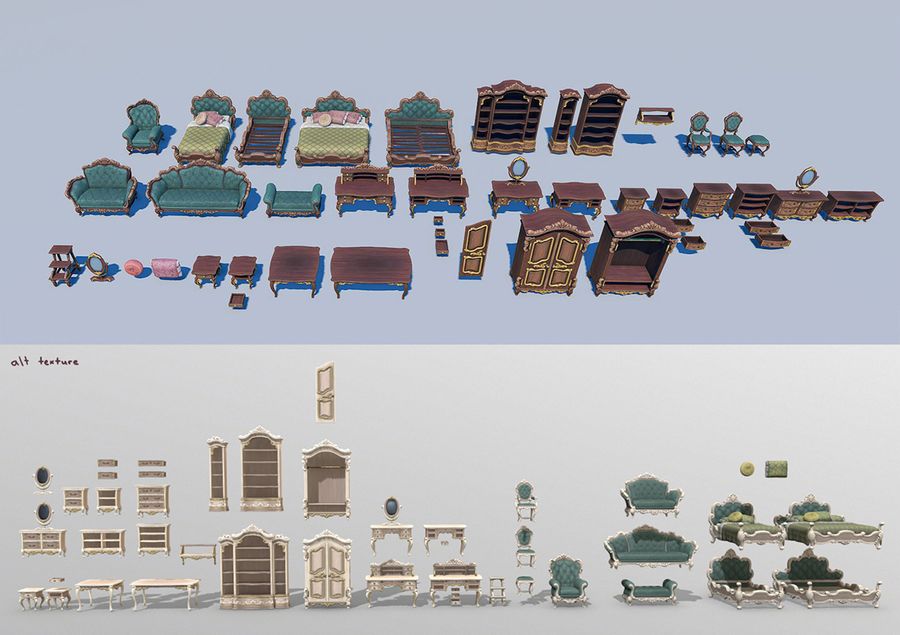
Asset Assembling Workflow Steps
- Make sure you have all the pieces needed to create all the assets that are required
- Make new mesh layers as required, and assembly the new meshes to the new layers
- Use the pieces wisely - most of the time, they don't need to be actually attached to each other, if they just look like they are
- However, don't leave any holes, and delete geometry that's left inside the model
- Use the pieces wisely - most of the time, they don't need to be actually attached to each other, if they just look like they are
- "Vessanpönttöily" and "juhlamokkailu" are also parts of the asset assembly workstep
- Make sure the assets have nice and natural unevenness and asymmetry in them, so that they fit the Trine style better
- It's better to add the wonkiness at this step rather than when sculpting, as it's easier to retopo symmetrical assets
- If your making blocksets, check 3D Asset Workflow: Blocksets - they need to match to each other more mathematically at times, so asymmetry can't be too radical
- Make sure the assets have nice and natural unevenness and asymmetry in them, so that they fit the Trine style better
- If needed, create new mesh layers for the same meshes different variations
- Three is usually a good amount of variations for the same mesh
- Note that the variations should look different enough from each other to make an actual difference
- Add separate parts (e.g. door frames, doors) to their own layers
- Make sure the pivots are in a sensible place - e.g. on the hinges of doors
- This makes them more usable to the level artists
- Make sure the pivots are in a sensible place - e.g. on the hinges of doors
- If needed, make billboards and/or very lowpoly background versions of the assets at this point
- When done, move onto 3D Asset Workflow: Naming the Asset
Asset Assembly Example Gallery
Asset Assembly Example Gallery
-
Also with an alternative texture
-
Also with a tintmask
